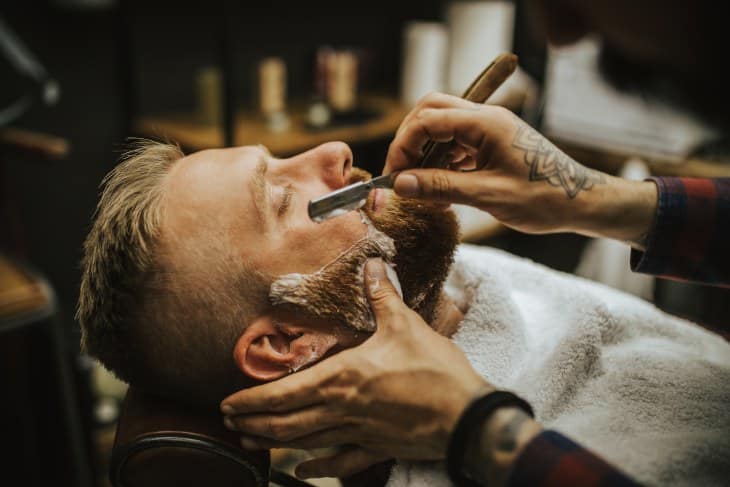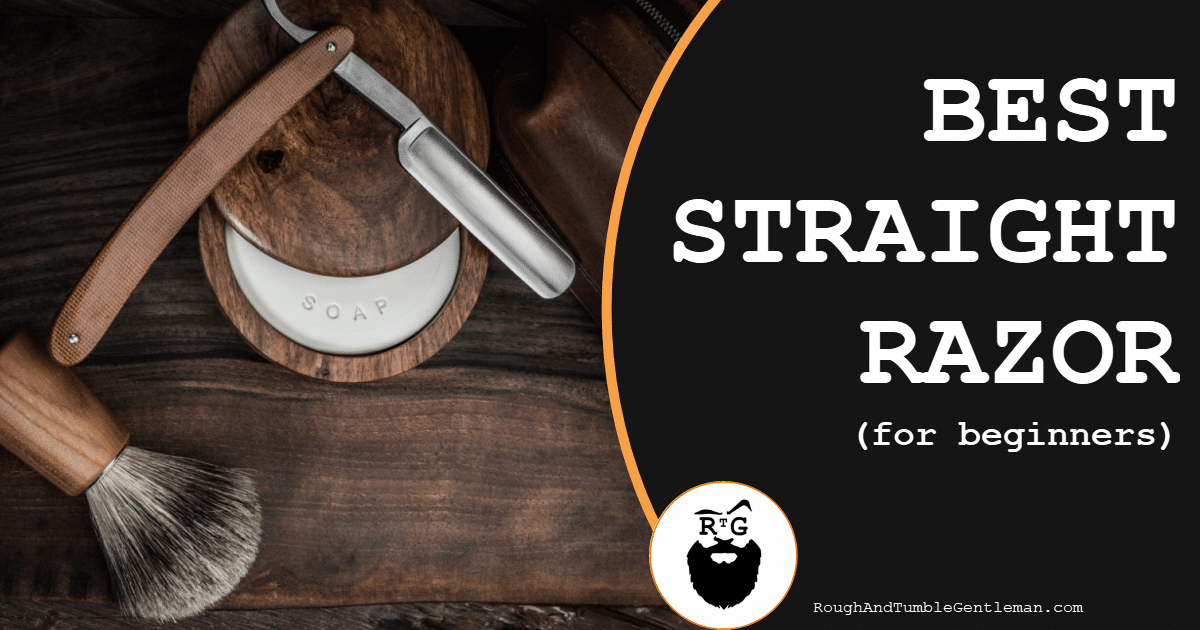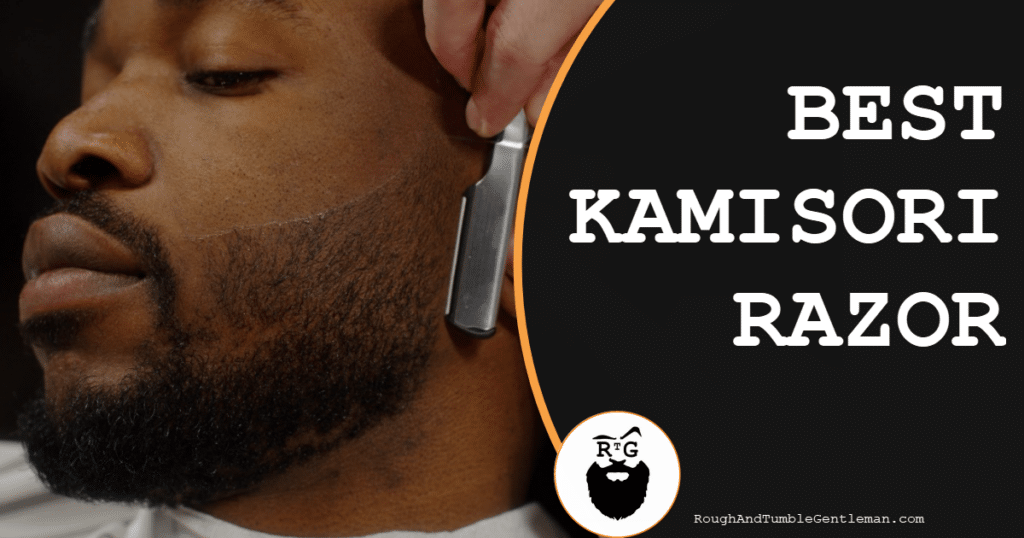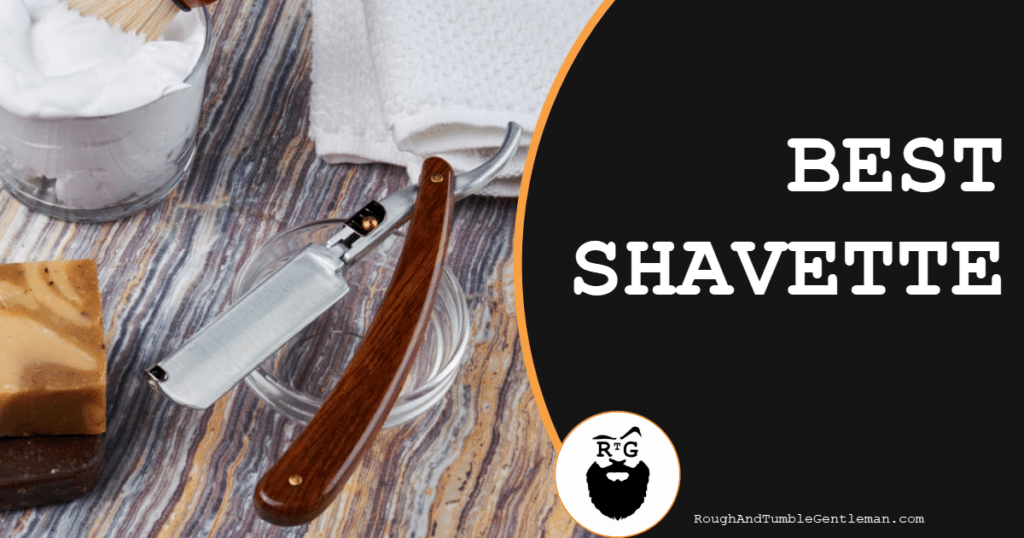Hello, and welcome! Here we’re going to provide you with an intro to the world of straight razors, along with our picks for the best straight razor for beginners. When it comes to a close shave, straight razors are the top, the peak, the PINNACLE—there’s simply nothing that will get you a closer shave than a straight razor, and there probably never will be.
And—they’re not for the faint of heart! Whereas safety razors may be what your grandfather used to shave, straight razors are what your grandfather’s grandfather used to shave. And there’s a reason for that: they’re intimidating! It’s literally a long open blade that you scrape over one of the most vulnerable parts of your body.
Like we said—not for the faint of heart!
But when used properly, they are incredibly tools that are deeply satisfying—if a little bit dangerous—to use. They connect you with traditions from ages past, and they—this never hurts—look absolutely gorgeous.

So, here are our picks for the best intro straight razors if you’re new to wet shaving. We’ve reviewed dozens of straight razors over the years, and we think the ones below are great options for guys who are new to the practice. We’ve recommended the models below to a lot of new straight-razor shavers, and gotten some great feedback.
With that, before we jump into our product reviews, we’re going to provide some intro information about straight razors. They are surprisingly complicated, and there are a lot of things you need to know to buy and use one, we’re going to make this into a sort of guide.
First we’ll provide summaries of the razors we think make the grade, then we’ll define some terms you’ll come across, then we’ll detail what to look for in a straight razor, and then we’ll get to the product reviews. You can skip right to the product reviews if you have First, some background experience with straight razors.
Capeesh? Alrighty, let’s get to it:
Quick Summaries of Our Top Beginner Straight Razor Picks
Here’s the quick overview of our favorite straight razors for guys who are new to straight-razor shaving:
Best “Buy-It-For-Life” Straight Razor: The Dovo Straight Razor. Calm and handsome with an olive wooden handle, this can be a “comfortable” shave that can provide an easy intro into straight-razor shaving
Most Unique / Stylish Straight Razor: The Naked Armor Straight Razor. Straight razors tend to look similar, but this is a bold, colorful option made of Japanese steel (and Japanese steel is a big deal in the world of straight razors)—easy to get the hang of
Best “Everything-You-Need-to-Get-Started” Pick: The Zertone Straight Razor. With a classic, wooden look, this has a “traditional” feel while coming with everything you need to get started—namely, a leather strop and a carrying pouch
Best “Low-Maintenance” Straight Razor: The Peinat Straight Razor. Straight razors need frequent stropping and maintenance, but this one needs less—making it a good option if you’re a busy guy (or you just forget to do maintenance-type tasks)—it’s got a classic look, and can make a great gift
Best “No-Maintenance” Option: The Utopia Care Straight Edge Package. With 100 replaceable blades, you can always get a “brand-new” razor feeling, and if you don’t want to maintain your straight razor at all—and there are plenty of guys like that—this is our recommendation
Best “Futuristic-Looking” / “No Maintenance” Model: The Parker SRX 100% Stainless Steel Straight Razor. If you like neo-noir looks, this is our pick—it’s a shiny, chrome replaceable-blade straight razor that is reasonably easy to learn and provides a VERY close shave.
Gents, we are reader supported. If you click on a link we may shave a small commission at no additional cost to you.

Before We Jump In: Some Straight Razor Terminology
The world of straight razors features some very odd-sounding shaving terms, so before we jump into our reviews, here’s a quick overview of some of the common words you’ll come across:
- Blade: This one seems obvious, but the blade refers specifically to the sharp part of the razor that cuts the hair—not the tail/tang, spine, etc.
- Scale: The handle of the razor—the area you use to hold the razor. The handle is sometimes referred to as the “scales” since it provides a counterbalance to the blade.
- Tail/Tang: In foldable straight razors, the tail is the rounded end of the razor that sticks out when the handle is folded.
- Spine: This is the back of the razor blade.
- Point/Nose: This is the topmost part of the razor blade. You should keep its shape in mind when choosing a straight razor, as we discuss further on.
- Heel: The bottom of the blade where it connects with the tail and the handle.
- Toe: The corner of the razor at the top, where the blade connects with the point.
- Edge: The edge of the blade is its sharp front side.
- Grind: This refers to the slope of the razor blade from the spine to the edge. For example, a full hollow grind is a very thin blade, while a half hollow is a slightly more tapered blade.
- Strop: A strop is a long strip of leather that is used to hone straight razors. Before or after every shave, it’s important that you run your blade over the strop to make sure your razor is aligned.
- Honing: Honing is a way of making sure that a blade isn’t bent or has uneven areas. After honing, a blade will feel sharper, although honing doesn’t sharpen the blade.
- Sharpening: Unlike honing, sharpening actually removes metal from a blade, to give it a finer edge.
Alright! Now that you have some background knowledge of straight razors, let’s read about…
Our Reviews: The Best Straight Razor for Beginners
We provided some summaries above—here, we’ll get into the details about each shaver, and for whom it may be a good match:
Pick #1: Dovo Inox Straight Razor

Dovo makes a luxurious, expertly-crafted, and widely respected straight razor in their Dovo Inox Straight Razor. It’s a great high-end option that we think is ideal for the “buy it for life” types. This could be both your first and last straight razor since we think its quality and durability mean it could last you for the rest of your days.
This gorgeous razor is made in Germany out of stainless steel, with a light-colored olive wood handle. It has a full-hollow grind, which means it’s quite flexible and able to fit with the contours of your face as you shave. This allows for a closer shave, which is great if that’s the main reason why you’re interested in shaving with a straight razor.
One major drawback is that this straight razor doesn’t usually come shave ready. Before you can use it, you will likely need to get it professionally sharpened. That’s a bummer, but once it’s professionally sharpened, it can retain that sharpness for quite some time.
This is a balanced and comfortable straight razor, and it’s usually the first we recommend to people.
Pick #2: Naked Armor Straight Razor

If you’re after a stylish straight razor, the Naked Armor Straight Razor offers a design with very unique flair. Our number two spot goes to this jaunty green straight razor, and not just because of how it looks. What we like about this razor is how hefty and balanced it feels in the hand. It’s a solid, durable design that we expect will last for decades, with a 5/8“ width that’s ideal for many sharpenings over a lifetime.
It’s made out of Japanese stainless steel, which is a durable, low-maintenance option designed to stay sharp for a while. Its grind is a little between full hollow and half hollow, which we find can be a nice choice for those who want a more solid and rigid blade.
It generally comes shave ready, although we’ve heard of mishaps where shoppers received dull blades. We’ve had good experience with Naked Armor, however, and they have sharpened straight razors for us (for free) when they did not arrive sharp enough. We don’t know if that’s still their policy, but we were very impressed.
This is a good razor if you’re looking for something with a little panache—something that’s very capable but also very unique and eye-catching.
Pick #3: Zertone Straight Razor

The Zertone Straight Razor Kit is a nice mid-range option for beginners who are interested in using a carbon steel razor over a stainless steel one.
This blade is made of carbon steel, so it can become incredibly sharp with the right level of care, although it may require more frequent stropping. This also means that it’s not totally rust-resistant, so you’ll need to keep it dry at all times.
This straight razor comes in a kit that also includes a strop and a carrying case, which is quite convenient for beginners since it saves you the need to go out and buy everything separately.
At just above 6/8”, this razor is slightly wider than our go-to recommendation, but not so large as to be unwieldy. Despite the larger size, it’s quite light thanks to the wooden handle. It can still offer you some precision, and just as importantly, it will likely hold up to decades of sharpening.
This razor has a rounded point, which is our preferred shape for those new to shaving since it can reduce the risk of accidental cuts.
While Zertone maintains that the blade will arrive to you pre-sharpened and only in need of a bit of stropping, that may not always be the case, so be careful, and make sure to test the blade for sharpness before using it the first time. If it doesn’t feel sharp enough, or you use it and it’s catching on your skin, consider having it professionally sharpened.
Pick #4: Peinat Straight Razor

If you’re after a different aesthetic (and you need a full set of accessories), the Peinat Straight Razor is another nice option. This razor has a “barber’s notch” which means that the point has a notch in its center, although the toe is still rounded to prevent accidents. It’s little details like that that we love about straight razors.
The handle is made of dark, smooth rosewood, which we think adds a timeless, masculine appearance to the tool. Like our pick from Zertone, this is another razor that comes in a kit that includes much-needed accessories like a strop and carrying case.
As for performance, this razor is made of stainless steel which tends to be more low-maintenance and beginner-friendly. Its grind is closer to half hollow than full hollow, so the blade is a little heftier than many of the other razors on our list, while the handle is fairly light. Be cautious when using it and keep in mind that it’s a slightly more aggressive option.
As with many other straight razors, it rarely arrives completely shave ready. While in some cases stropping it is enough, you may have to have it sharpened to achieve an adequate level of sharpness.
Considering how elegant it is and how many accessories it comes with, it’s hard to believe that it’s such an accessible mid-end option! We love recommending this one, because it “punches above its weight,” so to speak.
Pick #5: Utopia Care Barber’s Straight Edge Package

Technically, the Utopia Care Barber’s Straight Edge Package isn’t a traditional straight razor, but we always recommend it, because it eliminates the need for stropping: the Utopia Care Barber’s Straight Edge Package. It’s a mid-end barber’s straight razor, and unlike regular straight razors, a barber’s straight razor has replaceable blades, so it saves you the need to sharpen or hone a single blade.
In the case of the Utopia kit, this barber’s straight razor comes with 100 Derby Premium straight blades, which we like for their smoothness. If you’re not into them, however, this razor is designed to accept other blades, including regular DE blades broken in half. Nice!
The design is somewhat no-frills, which is not necessarily a bad thing. It looks utilitarian and masculine. Plus, who doesn’t like black? OK, maybe some guys, but it’s a pretty safe choice for a lot of guys.
It’s constructed with a lot of heft, which feels great in the hand but means it’s a little harder to control. Be extra careful when using it, and avoid applying too much pressure.
Overall, a great option for home use, and one used by barbers all over the world.
Pick #6: Parker SRX 100% Stainless Steel Straight Edge Razor

Parker is one of our all-time favorite straight razor manufacturers, and their Parker SRX 100% Stainless Steel Straight Edge Razor is a slightly more upscale barber’s straight razor that’s ideal for beginners who are pretty certain they want to stick with disposable blades. It comes from Parker, a brand with a long history and excellent reputation in the shaving community.
This barber’s straight razor is a hefty tool made of durable, rust-resistant stainless steel. It’s not quite as heavy as the Utopia razor, but it still feels excellent in the hand with exceptionally balanced scales. Sadly, it only comes with 5 Parker brand blades—and we’d love it if it came with more than that!—but it accepts most other half-blades, and replacing them isn’t the worst thing in the world.
Our favorite thing about it is the clip/lock mechanism, which holds the blade very securely in the razor, contributing to a shave that feels safer and more controlled.
Finally, we really like the look of this razor. It’s shiny and reflective, with retro decoration we think is very handsome. If you’re looking for a well-balanced straight razor but want to get away from the “traditional” looks, this is the one we recommend. It’s got a crisp, clean, sharp look, and looks right at home in more modern bathrooms and shave set-ups.
Alright! There you have it—our picks for the best straight razor for beginners. Now, as promised, we’ll dive into our “Ultimate Guide to Straight Razors for Beginners.”

Factors to Consider When Choosing Your First Straight Razor
Here’s what you need to keep an eye out for:
Grind—Opt for “Full Hollow”
Straight razors come with all kinds of grinds, but nowadays, a full hollow is the most common (and for a good reason).
Full hollow razors have a very thin blade, but with a more solid spine. They have some flexibility, which means they don’t break easily. They also bend easily against the skin, which allows for a closer shave while preventing cuts. The blade gives “feedback” as it hits any unevenness in the skin, which allows the shaver to adjust their technique.
Because full hollow razors are so thin, it’s much easier to get a very fine, sharp edge on them with minimal stropping or sharpening. If you find yourself debating between a few kinds of grinds (i.e. blade thickness or overall taper from spine to edge), full hollow is the way to go.
That said, it’s worth knowing about the other grinds you might come across on your journey!
Half hollow razors are a little less tapered, so there’s a bit more heft at the center of the blade. They’re still flexible, but not quite as much as full hollow razors, and because of the added weight, they’re a little more powerful when they shave. If you’re a beginner and you don’t want a full hollow razor for whatever reason, a half hollow can also work.
There are other hollow categories, like belied hollow, which is the thinnest option and could also be compared to using a barber’s straight razor. On the thicker end, there is the quarter hollow, which we think is too thick for most beginners.
Wedge razors are even thicker than a quarter hollow. Instead of a rounded taper from the spine to the edge, the side of the razor is actually totally flat, leading to a wedge-like shape. While these razors look very impressive, almost like an axe, we’d caution most newcomers to shaving to avoid them since they are too hefty and could lead to more drastic injuries.
Point Shape
The point (i.e. the top) of your blade can come in all kinds of shapes. It can be round, square, pointed, and even with a double curve. For those only shaving their own face, the shape of the point of the blade is mostly just aesthetic, but we think you should take into account how the sharp edge of your blade connects to it (i.e. the toe).
A squared-off point (sometimes called a spike point) can be a little dangerous, for instance, since it ends up having a very sharp toe which makes accidental cuts all too easy. Thankfully, in most square designs, the corner itself is still rounded which makes things safer. You can opt for a spike point if you like the idea of having a nice, sharp edge for cleaning up specific spots, but you’ll need to be a little more careful with it.
Shave Ready
It can be great for beginners to buy a shave-ready straight razor, although it can also be very hard to find.
What is a shave ready razor? A shave ready razor comes sharp and can be used straight out of the box. This saves you the need to spend a lot of time stropping or getting your blade professionally sharpened before you use it.
However, whether it’s because of shipping issues or just time spent in warehouses, many straight razors end up being relatively dull once they come to the customer, even if they’re advertised as shave ready.
The only way to be certain is to conduct a sharpness test when your straight razor arrives. You can do this by checking how easily it shaves hair from your arm, by touching the blade to your fingernail, and seeing if it cuts it easily. This is very similar to checking how to test the sharpness of a knife!
If your knife is relatively sharp, but not as much as you wish, make sure to strop it a few times to give it a straighter edge. If that’s not enough, you will likely need to send your straight razor to a professional sharpening service.
Material
Straight razors are most commonly made of either carbon steel or stainless steel, and there are benefits and drawbacks to each option.
Stainless steel is a modern innovation. This alloy (i.e. a blend of metals) is usually made up of iron and chromium. The chromium added to the iron prevents rusting, making for a straight razor that is more suitable for wet shaving.
The main benefit of a stainless-steel straight razor is that it keeps an edge for a long time and doesn’t need to be sharpened or honed too often. It’s a durable, long-lasting option that requires minimal maintenance. However, sharpening it at home is not as easy, so when it does finally lose its sharpness, you may want to send it to a professional.
Carbon steel is another popular straight razor material that has some avid fans, especially amongst long-time straight razor shavers. It’s an alloy that is very high in carbon, which makes it much harder than its stainless-steel counterpart.
Oddly enough, hardness doesn’t result in better durability—quite the opposite! Unlike stainless steel, carbon steel rusts a little more easily. If you do choose a carbon steel razor, make sure to dry it completely after you shave, and then store it somewhere safe away from moisture. You may also need to coat it in blade oil every once in a while, especially if you live in a humid climate.
Carbon steel is also more rigid, which means that it’s a little more brittle. This may sound like a drawback, but that’s not actually the case. Because it’s a little harder and more brittle, carbon steel can be honed to a much finer, sharper edge than a stainless-steel blade.
If you pick one up, you’ll have to strop it more frequently, and you may also want to learn how to sharpen it by yourself at home. It’s a bit more work, but it’s not as though anyone gets into straight razor shaving because it’s low maintenance.
All-in-all, it’s up to you what you’d prefer. We think most beginners will prefer the durable, low-maintenance but slightly less close shave of stainless steel, but we have a lot of respect for the rare few who’ll choose the high-effort but ultra-sharp carbon steel option.
Width
A large straight razor with a long, wide blade can be tempting. Just imagine how quickly such a razor could move over your skin and remove hair! You’ll also know that it’ll keep for decades, no matter how many times you sharpen it. However, when you’re new to straight razors, it’s better to start a little smaller.
Usually, straight razor sizes are discussed in terms of width from the spine to the blade’s edge, with 5/8 of an inch being the most common, followed by the slightly larger 6/8”.
These are both medium sizes that offer a good balance—enough precision to hit smaller areas, but large enough that you can quickly remove hair from your cheeks, even when your whiskers have gotten long.
5/8 of an inch is also wide enough to handle being sharpened multiple times over the course of multiple people’s lifetimes. In other words, it’s definitely the kind of straight razor you could one day give to a child or grandchild!
While there’s a minimal difference between 5/8“ and 6/8”, there is one situation where it can make a difference. The slightly wider blade can do an easier job of removing long beard hair. If you’re the type to keep a full beard that you shave off completely a few times a year, you may prefer a 6/8” blade.
On the other hand, you may want to go the opposite route and choose a smaller razor if you’ll only use it to maintain an existing beard. A smaller razor will fit more easily into the hard-to-reach spots under your nose or jawline, and it’ll give you full control as you sharpen the lines of your beard.
Weight
When it comes to safety razors, we’re all used to preferring heavier designs that will do all of the work for us. The heftier the razor, after all, the more force that will go into each cut and swipe.
However, with straight razors, the exposed blade design is already far more aggressive. As such, the ideal straight razor for beginners will offer just enough heft to feel comfortable and durable in your hand, but not so much that it doesn’t allow you to control your movements.
Weight also correlates with grind, with full hollow grinds as the lightest option (that we think is best for beginners) and wedges as the heaviest.
Scales and Balance
It can be hard to judge balance on your own, so we tried to do the work for you when curating our recommendations. A great straight razor for beginners and pros alike will have a balanced handle. Perhaps that is why we call the handle of the straight razor scales.
Whether you opt for a lighter or heavier straight razor, what’s important is that the razor’s center of balance (i.e. where it’s heftiest) is at the point where the handles and blade meet.
The handle itself shouldn’t be much heavier or lighter than the blade itself—they should be weighed evenly. This allows for a more comfortable hold as you shave, and makes it a little easier to maneuver and change positions as you work.
Barber’s Straight Razors vs Traditional Straight Razors
In this post, we largely focus on traditional straight razors, but some newcomers to shaving may choose to try a barber’s straight razor instead.
Whereas traditional straight razors are designed with a durable, knife-like blade, barber’s straight razors are designed to be used with disposable blades. They’re often also referred to as shavettes.
In a busy barbershop, it’s a lot more convenient for the barber to use a disposable blade since it’s difficult and time-consuming to adequately disinfect and hone a traditional straight razor between clients.
For newcomers to shaving, however, the benefit of a barber’s straight razor is that it saves you the need to constantly hone your blade—all you’ll need to do is replace it. Many straight razor shavers will actually pick up a barber’s razor for travel since they can put it in their carry-on without the blade.
However, where you save on convenience, you lose out in a few ways. First, and most obvious: Barber’s straight razors are not as eco-friendly or low-waste as regular ones. But, much like safety razors, they’re still better for the environment than large disposable cartridges.
Next, while the basic hold and movement for both types of straight razors are similar, shaving with them is still quite different. Barber’s straight razors are usually more lightweight, so the user has to work a little harder to control and provide pressure as they shave. Because the blade is effectively just an exposed half of a double-edge razor blade, they’re even thinner than full hollow straight razor blades, and the risk of accidental cuts is a touch higher.
We think that for most beginners, barber’s razors are a little difficult to use. It’s easier to transition from a regular straight razor to a barber’s straight razor than vice versa. If you’re the kind of person who’s not afraid of any challenge when you shave but you’re not ready for the effort of maintaining a straight razor, go for it… But don’t say we didn’t warn you.

Why Buy a Straight Razor?
Straight razors can seem intimidating to those new to shaving, but that’s also what makes them so cool.
Today, it’s only barbers and hardcore enthusiasts that still use straight razors. To understand why that’s the case, here are the main benefits of shaving with one.
- Very close shave. With a straight razor, there is nothing separating the blade from your skin, so it provides the closest and most aggressive shave possible. If you’re not okay with even a hint of stubble after you shave, a straight razor will give you the baby smoothness you’re after.
- Multi-use. A straight razor can provide you with an ultra-smooth shave all over, but it’s also a great tool for precision work. By altering how you hold the razor and which part of the blade you use against your skin, you can achieve an ultra-crisp neck or cheek line. This level of control is difficult to achieve with other types of razors.
- Low-waste. A traditional straight razor is a long-lasting tool that doesn’t have any disposable components. If you’re committed to reducing the waste you produce and having a more eco-friendly lifestyle, it’s one way of making your grooming routine a little more sustainable.
- Old-school style. Part of the reason why many of us love wet shaving is because of its masculine aesthetic, and rest assured, a straight razor provides that in spades.
- Master a challenge. Straight razors are not easy to use, and there’s a bit of a learning curve as you unlearn old habits. That may not seem like a benefit (and we imagine it’s not a benefit for many wet shavers), but if you’re here, you probably don’t shy away from a challenge. Learning how to shave with a straight razor is an amazing accomplishment and a skill you will be proud to gain.
Is It Hard to Learn to Use a Straight Razor?
We definitely wouldn’t say that learning to use a straight razor is easy, but then again, things worth doing rarely are! It’s also not so difficult that it’s impossible to do. We think that the two hardest parts about learning to use a straight razor are developing patience and letting go of previous habits.
What do we mean by patience? Well, the key to becoming an excellent straight razor shaver is learning how to grip and control the new blade. You’ll need to practice gripping your razor correctly, and holding it at a 30-degree angle against your skin. The first few times, you’ll want to work very slowly to ensure that your angle is on point.
As for unlearning previous habits—gripping a straight razor is totally different from holding a safety razor or a commercial cartridge razor. You’ll need to be careful not to default to previous techniques, lest you angle the straight razor too sharply against your skin and end up cutting yourself.
Finally, learning to use a straight razor also involves learning how to keep it honed with a strop. Once again, it’s not that this is difficult, but it does require some practice and effort.
Good Luck on Your Wet Shaving Journey!
Straight razors really are “the final level” of wet shaving. Learning how to use such a sharp blade presented in such an odd shape is the hardest part, but with a high-quality, beginner-friendly straight razor in your possession, it’s very doable, and most guys get the hang of it before too long.
Hopefully there’s something here that helped you—choose your new shaving companion, strop it a few times (now that you’ve learned what that means), and happy shaving!
Michael Morris is the head writer here at Rough and Tumble Gentleman. He's got a ducktail beard and loves Brazilian jiu-jitsu. He's married to the woman of his dreams and lives in Brooklyn, NY.




